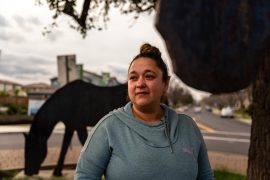Covered California Unveils Ad Campaign, Awards $14.6M For Outreach
And new enrollment numbers for that state show a growing individual insurance market, officials said. Meanwhile, a Nebraska woman recounts her experience as a navigator, and Oregon officials say a tax credit error will affect fewer people than expected.
Los Angeles Times: California Health Insurance Exchange Unveils Ad Campaign And Outreach
Preparing for the second year of Obamacare enrollment, California unveiled new television ads and handed out $14.6 million to community groups for consumer outreach. The state-run insurance exchange, Covered California, said the new grant funds are in addition to $33.4 million that has already been given to clinics, unions, schools and nonprofit groups helping with enrollment (Terhune, 9/15).
Kaiser Health News: Capsules: California Exchange Seeks To Enroll 500,000 More People
Covered California, the Golden State’s online health insurance marketplace, announced Monday that it will be spending close to $100 million as it aims to enroll 500,000 new people during the second round of open enrollment, which begins in two months. The state also will be trying to help about 1.2 million Californians renew health plans they received thanks to the nation’s Affordable Care Act during the inaugural enrollment period last fall. The numbers do not include the roughly 2 million who signed up for Medi-Cal, the state’s health insurance program for the poor (Hernandez, 9/16).
California Healthline: New Enrollment Numbers Temper Fears of Individual Insurance Market Crash
It turns out the sky hasn't really fallen on the individual health insurance market. The Department of Managed Health Care last month released individual market enrollment numbers through May 1, 2014, showing growth in the market. ..."They show that, even with just one regulator reporting, the individual market is doing really well," said [Richard Figueroa, director of the health and human services department at the California Endowment]. ... More important to Figueroa, though, is the numbers show him that the health benefit exchange is not only working, but affecting the rest of the market outside of the exchange (9/15).
Lincoln Journal Star: Woman Recalls Time As Health Care Navigator
Sometimes the work Cindy Balliet did this past year touched her heart. Balliet helped a woman with chronic back pain get enrolled in the new federal health insurance program. Balliet was one of 50 people trained and licensed to help Nebraskans "navigate" the new health insurance system. She was one of nine navigators paid to work full-time at Community Action Partnership offices across the state. But the experience of working with people who desperately wanted insurance they could afford made her appreciate the program, even with its initial problems (Hicks, 9/15).
Oregonian: Cover Oregon Health Insurance Tax Credit Error Affects Fewer Than Thought, Officials Say
An error in Cover Oregon's tax credit formula will affect fewer health insurance consumers than feared, officials said Monday. Cover Oregon officials told lawmakers in Salem that a survey of 39,000 households receiving the tax credit to reduce premiums found only 775 of them are affected by an incorrect formula used by the health insurance exchange, not the greater number feared. About 3,400 households haven't yet been reviewed. Exchange officials said while they were not pleased about the error, they are pleased the number isn't larger (Budnick, 9/15).
And, on the topic of Medicaid expansion --
The Associated Press: Arkansas Requests Changes To Private Option
Arkansas asked the federal government Monday to allow changes to the state's compromise Medicaid expansion that would require some participants to contribute monthly to health savings accounts and would impose new limits on transportation for non-emergency services. The state Department of Human Services submitted its proposal to change the "private option" program, which uses federal Medicaid funds to purchase private insurance for low-income residents. It was created last year as an alternative to the Medicaid expansion envisioned under the federal health law. More than 194,000 people are enrolled in the private option. Lawmakers earlier this year required the state to win approval for the changes by Feb. 1 in order to keep the program alive (DeMillo, 9/15).






